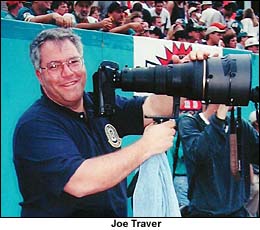|
 Joe
Traver died last month. Joe
Traver died last month.
Let's get this hard part out of the way - he killed himself. He had
been arrested in his home, on charges of sodomy, based on the testimony
of a young man he had befriended, who was serving time in jail. In the
process of the arrest, by black-uniformed members of the sheriff's department
swat team, one of the deputies accidentally shot and wounded himself.
As a result of the furor surrounding the shooting, it became a big story
in Joe's home market of Buffalo.
His friends and colleagues photographed him on a "perp walk,"
and one even went so far as to ask Joe to arrange TV coverage of his
own trial. It was just too much for a person who had prided himself
on reaching out to his chosen profession of photojournalism all of his
life. So he took some pills and ended his life.
In the days following, there was a torrent of email on the National
Press Photographers' discussion list. First, about the incident, then
his death. Finally, there was a note from a bewildered young photographer
that asked, "Who was Joe Traver, anyway?" Let me try toanswer
this question.
If you were a member of the National Press Photographers Association,
or took part in any of their educational programs, or were assigned
to the 1996 or 2000 Olympic Games, or covered professional football,
or were simply a young photographer looking for a helping hand, the
chances are your life was affected by Joe Traver.
He got his start in 1977 as a staff photographer for the Buffalo Courier-Express,
where he worked until 1982. When the paper folded, he decided to start
freelancing, working for, among others, Reuters, The New York Times,
Sports Illustrated, Gamma Liaison, and Black Star. His clients over
the years included The LA Times, The New York Post, Newsday, USA Today,
The Houston Post, The Boston Globe, Time, Newsweek, Business Week, Forbes,
Fortune, and National Geographic.
In 1993, he took time out to get a master's degree in labor and policy
studies at the State University of New York. He was also the Buffalo
Bison's official photographer from 1981 to 1991. In 1989, he was feted
at the Pro Football Hall of Fame in Canton, Ohio, as Pro Football Photographer
of the Year - this followed his winning "Photo Of The Year,"
which showed jubilant Buffalo Bills fans after the Bills beat the New
York Jets in overtime during an AFC East playoff game.
It was, however, Joe's tireless efforts on the part of the group he
loved the most, The National Press Photographers Association, that is
his true legacy. He joined the NPPA while a student at Syracuse University
in 1973. He had a deep and abiding belief in the importance of education
for photojournalists, which culminated in his co-founding the NPPA Northern
Short Course that provided seminars and workshops for photographers.
In 1993, after serving seven terms on the NPPA Board of Directors, he
was elected National President of the organization, and helped to steer
the NPPA through its 50th anniversary year.
In 1996, he was selected as the Deputy Photo Manager for the 1996 Atlanta
Olympic Games, and returned to coordinate all photo coverage for the
2000 Olympic Games in Sydney, Australia.
These are the dry facts. What they do not tell you is how hard he worked
during all these years, not only to excel at his profession, but how
much time he put into helping other photographers. As Arnold Drapkin,
who worked with Joe for years as Director of Photography at Time, then
helping him at the Olympics has written, "As a mentor to many,
along with photography, he taught those old-fashioned virtues of hard
work, perseverance, loyalty, and team work. Still photography had a
champion at the Olympics. He worked hard to maintain and improve the
conditions that enabled photographers to make their memorable images.
The NPPA was truly a second career to him, and education, professional
ethics and the welfare of his peers were his priorities."
In an open letter to his friends, written just before taking his life,
Joe said, "I have had a great life. I have been to the mountain
with Muhammad and have seen the other side. I have had the opportunity
to do more than most, and have been blessed with a plethora of the best
friends on earth. It has been a priority of mine often and frequently
to utilize assistants and help a few others to see the joys and hard
work of photography. The NPPA has been my second career for 24 years.
I have firmly believed the adage that it is important to give back to
the career that has helped you so much." In his final words, he
said, "Please remember me as the big guy with a
smile and open heart."
Well, we do, through the tears.
|